Lisa Dawn's Blog: The Princess Blog, page 36
June 19, 2022
Netflix Is Adapting The School for Good and Evil, So I Read the First Book!
The School for Good and Evil is a middle grade book series released in 2013 with a similar plot to Ever After High and Descendants and with all the ambition of Harry Potter. Considering how popular this fairy tale-inspired series seems to be, I'm surprised I never heard of it until a little over a week ago when I learned that Netflix is turning it into a movie. Perhaps one of the reasons it was so overlooked is its super generic title, which sounds like it could be about literally anything. Most fictional stories are about the battle between good and evil. A better title would have been The School for Princesses and Witches, which would have been more eye-catching to lovers of fairy tales. Maybe the vagueness is good, though, since this book contains many horror elements that could scare off young fairy tale aficionados or particularly sensitive older ones like myself.
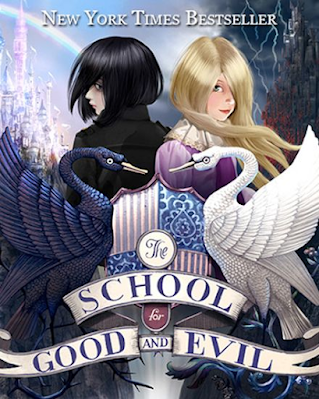
When I began reading The School for Good and Evil, I had many questions that were mostly resolved by the end, but not entirely. The author threw around so many contradictory ideas that the school that made no sense, even for a fantasy world. Ever After High, which came out the same year as this book, did a better job of creating a school for fairy tale characters because the classes weren't separated based on who is a "royal" or a "rebel," meaning students could study whatever they wanted just like a real school. The characters were all descendants of the famous ones from storybooks, which eliminated the issue of altering their childhoods. Here, students are kidnapped and forced to attend whichever school is chosen for them whether they want to or not, particularly in the case of Sophie, who spent her entire life dreaming of becoming a princess and is essentially thrown into prison with a bunch of monsters who debate whether they should kill her or not upon meeting her for the first time. This school is allegedly where every famous fairy tale character got their start including ones like Cinderella, Snow White, and Rapunzel, who all spent their childhoods in isolation and abuse. Attending a school where they were supported by friends and teachers would have changed the outcomes of their stories, but that is never addressed here.

Questionable world-building aside, the plot is a mash-up of Wicked and Descendents 3 . It focuses on Sophie and Agatha, two girls who are the best of friends but could not be more different. Sophie wears fancy dresses and walks around in glass slippers on a daily basis (ouch), dreaming of the day she'll get kidnapped and begin her fairy tale, while Agatha is a goth recluse who lives in a graveyard and carries around dead animals to remind everyone about the value of life. When Agatha is sent to the "good" school filled with other wannabe princesses and valiant princes while Sophie is sent to the "evil" school and forced to take classes about how to make herself more ugly, Sophie flies into a jealous rampage that leads her down a path befitting of her new school. The book raises many questions about what "good" and "evil" really mean by making the good characters shallow and superficial, while the evil characters have an honor system and prefer to be ugly so they can be appreciated for their talents rather than their looks. This makes the mix-up between Sophie and Agatha particularly confusing because Sophie is no different from any of the other girls at the "good" school who probably would have responded just like her in her place. Meanwhile, Agatha, who is supposed to be "good," refuses to let Sophie live out her dream because of her selfish desire to have her all to herself. Of course, the ambiguity of human nature was probably the whole point that the author was driving at. It just could have been done better if everyone wasn't so fixated on their appearances. If all the villains who attended the school were taught to value ugliness over beauty, how would they explain the jealousy of wicked stepmothers?
I can understand why someone might read this book and think it would make for a good movie. There are a lot of cinematic elements and horror movie imagery reminiscent of the Harry Potter series. Parts of it would need to be toned down if the movie has a similar target audience as the books of 9-12 years old, which I personally think is too young for this series. There were several things that I felt were inappropriate for middle-grade readers, including forced dressing and undressing that I would equate to a minor form of assault. I hate to admit it, but I could tell this book was written by a man due to the gratuitous nudity of young girls as a result of magical transformations as well as the way he viewed girls as being obsessed with their appearances and finding boyfriends and pretty much nothing else. Still, if done right, this story would make for a compelling film. Sophie and Agatha are great characters with different strengths and weaknesses. Agatha puts up with Sophie's abuse out of her desire to always be with her, while Sophie suffers in a school she never asked to attend and is willing to take down everyone and everything in it to get what she wants. As someone who also dreamed of being a princess, I was a little triggered by the accusations the book threw at her about how wanting to be the heroine of a fairy tale doesn't necessarily make you a good person. The book really got under my skin and made me think even when I wasn't reading it, so I give the author props for that.
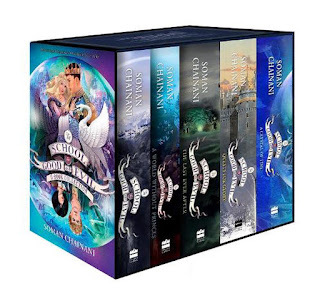
There are currently six books in this series, and they are quite long, so I doubt I will be reading the rest. However, I will probably watch the Netflix movie to see how the dark imagery described in the book translates to the screen. There's an interview with the author at the end of this book about it being picked up for a film by Universal Studios back in 2013, but I doubt this is the same movie. I can understand why a well-known studio would have wanted to bring such a visual concept to the screen, so I'm not sure what happened to that version of the film. I suppose Netflix had to wait a few years to get the rights from Universal once the project was canceled. Considering how risqué Netflix tends to be with their content, I hope no children get traumatized by this film. Even though I was a little traumatized by the book, myself, I found it to be a thought-provoking experience overall. I recommend The School for Good and Evil series to people who enjoy comics like Fables from Vertigo Comics or Grimm Fairy Tales from Zenescope, which mix the horror elements with well-known fairy tales. The Netflix film does not have a release date yet, but it is said to come out this fall.
June 15, 2022
Review: Time Princess - Miss Kitty's Antiques
At this point, I think the game should change its name from Time Princess to Time Demon because it has a significantly higher number of stories about demons (but not the evil kind) than princesses, the latest one being no exception. Miss Kitty's Antiques begins as a murder mystery and evolves into a story about ancient Japanese mythology. I was surprised by many of the twists and turns it took and pleased with the touching romance. The main character is a cat yokai, which means she is a cat spirit who can transform into a human, and she has some kawaii over-the-top cat-inspired outfits to match.
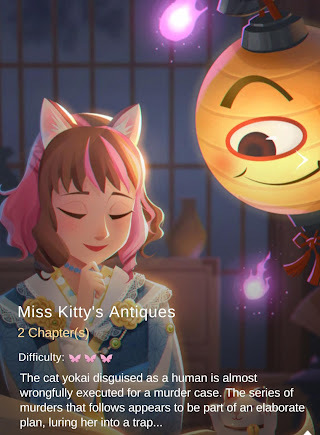
Lady Mangetsu is a cat spirit posing as a human who runs an antique shop as a cover for her quest to find the Origin Pearl to save her dear friend, Yuta, a ninetails fox yokai. Her life is already pretty interesting before she gets framed for murder when she discovers a dead body. The first half of the book is set up like a typical murder mystery, but the plot takes a drastic turn in the second chapter when Mangetsu learns the truth about the Origin Pearl and her own past. Despite being a yokai, she is unable to use magic, nor can she remember anything before ten years ago. It turns out that there is a good reason for all of these things, and there is a lot more to her past than she realizes. The story goes from a crime drama to a quest of self discovery, both of which are done equally well.
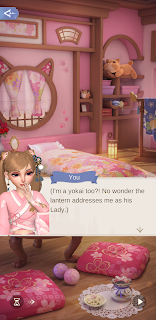
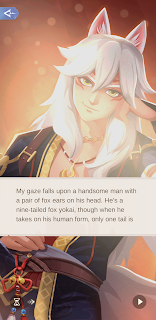

This visual novel contains three companions, though the third one's identity is a bit of a spoiler. Whichever one you choose as the main love interest drastically changes the story in the second chapter. This is the most romantic book that Time Princess has released in a while. I was genuinely touched by the passion Mangetsu shares with Yuta, who was my favorite of the three companions. They have a tragic love story that is typical of what one might find in old Japanese myths. It doesn't hurt that he's also pretty easy on the eyes. Tenho is a human from the onmiyoji clan, which is the enemy of the yokai. As such, he is pretty rude to both Mangetsu and Yuta for most of the story, but choosing his ending reveals an unexpected surprise. The third option was my least favorite of the three, but it certainly made for some dramatic storytelling!
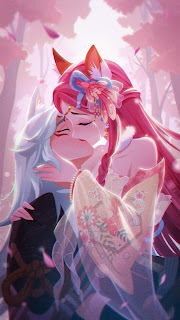

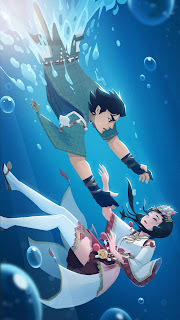
There are a few other Japanese stories in Time Princess, but the clothing in this one is my favorite out of all of them! Mangetsu has such a vibrant wardrobe of adorable cat-themed outfits along with some lovely dresses. I especially enjoyed the bright colors and cute floral and cat-ear hair accessories. The dresses are pretty short, so I wouldn't consider them historically accurate, although I'm not sure at what point in history this story was supposed to take place. If I had to pick a favorite, I suppose I'd go with her golden fox dress with flowing chiffon sleeves, pink ribbons, matching hair, a blue floral sash on her obi, and big fluffy fox ears. It's hard to pick just one when all the outfits in this book are so gosh darn cute!
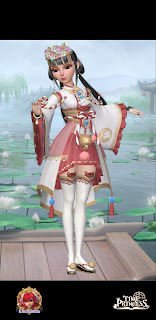

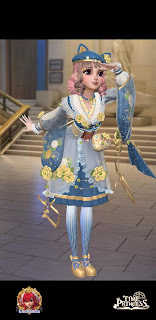
It seems like the developers of Time Princess are taking pity on their players for having to pound through so many visual novels each month because the level of difficulty for story completion has gone way down. I barely needed to replay any levels to get all the endings, and I never had to check the flowchart or a walkthrough to figure out what I was missing. Most decisions are solely to raise points with your chosen love interest as opposed to changing the story, which I appreciated. I'd say Miss Kitty's Antiques is a hit. It incorporates so many different ideas from crime dramas to mythology that work surprisingly well together. I also liked how the story map creates a shape that vaguely resembles a cat.
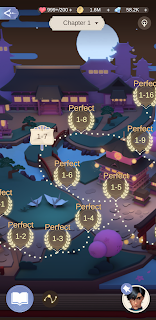

June 12, 2022
Review: Court of Swans

This book takes place in 14th century London and tells the story of a young woman named Delia whose brothers were arrested by the king on false charges. As the only one who was not placed under arrest, Delia takes it upon herself to infiltrate the castle and free them. Though she is advised not to reveal her true identity, she accidentally blabs to two knights who offer to help her. I found this relatable because I have trouble lying and keeping secrets as well. Of the two knights, one of them kept his promise, and the other turned out to be a jerk. Both were taken in by Delia's charms and the sincerity of her desire to help her brothers, who did everything they could to avoid their impending execution. However, they would not have been able to escape without the help of Delia and Sir Geoffrey.
Though I found this to be a pretty sweet story overall, I thought the Christian message was somewhat heavy-handed. The book had a clear theme of "Why do bad things happen to good people?" and the answer it kept giving was that God would save them if they were truly innocent. Yet, it was only through the dedicated efforts of Delia and Geoffrey that the brothers had any chance of being pardoned from their sentence. There was even one casualty in their escape that the book overlooked as self-defense, which seemed a little hypocritical given its strong moral message. The discussion questions at the end, which were probably meant for students, seemed particularly pushy about the way readers were meant to interpret the book.
What I liked the most about this book is how the author managed to adapt the main elements of the fairy tale in a way that could have actually happened. I've seen this done before, and it doesn't always work as well as it did here. In "The Wild Swans," the heroine's brothers were cursed by their evil stepmother, who transformed them into swans. Locking them in a dungeon under false pretenses is an equally unfortunate curse. The heroine in the fairy tale had to free her brothers by sewing them sweaters made of nettles and not speaking a word until the day the curse ended. Here, Delia also sewed some sweaters to keep them warm in the dungeon, but she had to resort to more practical means to free her brothers, including keeping her relationship to them a secret. The book even incorporated the aspect of the fairy tale in which one of the brother's arms did not transform back after the curse was broken.
This book made me curious about Melanie Dickerson's other fairy tale adaptations. She has a good eye for history and retelling stories in a practical way. It isn't the most exciting book I've ever read, but it had a lot of heart. The lengths that Delia was willing to go through for her brothers were quite touching, and I enjoyed seeing how the love triangle unfolded as well. I would recommend checking out any of her books if you are in the mood for a light historical romance inspired by a well-known fairy tale.
June 9, 2022
Love After World Domination Flips the Modern Princess Trope on Its Head!
What if princesses were not daughters of kings, but members of an army trained for the destruction of mankind? That would explain why they are always such powerful fighters these days. The new anime series Love After World Domination does just that, but with a twist. It has a Power Rangers-inspired setting with a plot reminiscent of Romeo and Juliet. In the same way that Sleepy Princess in the Demon Castle parodies the trope of princesses getting kidnapped, this anime takes the modern trope of princesses being skilled warriors and takes it in an unexpected direction. That's just one of the reasons that Love After World Domination is my favorite new anime this season.

The show starts like any other Power Rangers series with a team of five color-coded warriors (sentai) fighting against a female-led legion of monsters. It is then revealed that this rivalry is a ruse, at least on the part of the Red Ranger, Fudo, and the opposing Reaper Princess, Desumi. Though Desumi is a powerful fighter and works for the evil legion known as Gekko, it is revealed that she only does this out of obligation to her family and her overachieving nature. If it were up to her, she'd rather be an ordinary high school student. Fudo catches on to this and asks her on a date. They begin a secret relationship behind closed doors while the rest of the world sees them as enemies. Those who learn the truth behind their relationship of it are surprisingly accepting, especially the other sentai. This is due to Desumi's warm and magnetic personality, which is closer to older Disney Princess tropes than the newer ones.
One thing that makes this show unique is the unique way that it establishes its princess archetype. There is a lot more focus on Gekko than on the Power Ranger base. Gekko is run on a hierarchy in which generic-looking reaper characters that represent the Putty Patrollers from the original Power Rangers are on the lowest tier and are commanded by powerful women known as Princesses, who are in the middle tier. When a princess is successful enough, she is offered a promotion to become a beast and have her DNA genetically enhanced with an animal to become a powerful monster. Desumi is offered this promotion to the distress of her jealous princess colleagues, but she turns it down because being a monster would make it harder for her to wear cute outfits and paint fun designs on her nails. So precious!
What I love about this anime is that it subtly pokes fun at the fact that modern princesses have gone so far in the opposite direction that it's more difficult than ever for a modern princess to live like a traditional one, even if that's what she wants. Desumi is indeed a powerful fighter despite her cute appearance, but she was roped into being the Reaper Princess due to peer pressure from people who admire her fighting skills. If it were up to her, she would much rather go on dates with Fudo than be forced to battle him for public acclaim. In other words, she'd rather be what a princess used to be before the archetype changed to a fierce warrior who crushes everyone in her path.
Love After World Domination blasted its way into my heart as one of my favorite anime series of all time. After watching Power Rangers as a teenager, it's refreshing to see a series that focuses on how the villains' organization is run instead of the heroes. It is a little different from the original Power Rangers shows in that the sentai don't keep their identities secret. I think the writers made this decision because it would have been too excessive for Fudo and Desumi to have to hide their identities as well as their relationship. It also would have put less pressure on them if they could date in their civilian forms with having to worry about being recognized. I love this show's playful commentary on what princesses have evolved into vs. what they once were. Love After World Domination is currently airing on Crunchyroll. Are you a fan?
June 7, 2022
First Trailer for The Princess
The first 30 seconds of The Princess trailer begin with fairy tale imagery (or the closest thing they could find in this film) with a narration that states "Once upon a time in a magical castle, the king's daughter was locked away in a tower." I can only assume that the "magical" part was intended to be sarcastic because there is nothing in this trailer that remotely insinuates any hint of magic. It is an action movie wearing the skin of a fairy tale, which becomes especially clear when the narration is abruptly censored and the imagery becomes splattered with blood. Despite seeing so many warrior princesses in the past decade that it's become a tired stereotype, the trailer expects its audience to be surprised that the feisty protagonist is fighting back to protect herself and her kingdom.
I think the specific flavor of irony that the movie is going for is that the Princess (Why doesn't she have a name?) doesn't dress like a warrior despite being highly trained in fighting. According to the presentation of the trailer, she runs away from her wedding in a beautiful white dress and proceeds to massacre anyone who gets in her way, causing the dress to get torn and splattered with blood in the process. There are some minor costume changes later on such as a leather chest plate and bracers, but she never loses the frilly skirt no matter how tattered it gets. This juxtaposition is a bit less common, but it has also been done before. The freshest example in my mind is when Princess Bean ran away from her wedding in the first season of Disenchantment.
When this movie was first announced, I was wondering why it would be getting a Hulu release instead of Disney+, but that's pretty clear from the way the trailer was presented. I'm sure Disney would have gotten an earful from concerned parents if they released a trailer for a new movie their platform that said "These guys ****ed with the wrong princess." If shock value is all this movie has to offer, it will likely be a flop. Keep in mind, however, that even Shrek ended up having a ton of heart, so maybe there will be more to this film than meets the eye. We'll find out on July 1st when it drops on Hulu.
One last thing I want to note is that when I was researching this movie, I accidentally stumbled upon another film with the same title that is also set for a release this summer. This one is a documentary about the life of Princess Diana. It is unfortunate that it was given the exact same name as a completely unrelated movie set for release the same year. It is also unfortunate that it is being released less than a year after the tragic Broadway Diana musical that left a sour taste in people's mouths. If you are a fan of Princess Diana, I suggest not letting either of these coincidences hinder your research or enjoyment of the upcoming documentary.
June 5, 2022
Review: Spindle Fire Duology
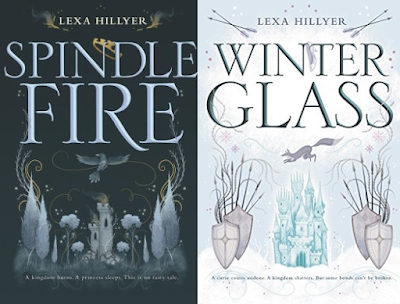
Spindle Fire is a re-imagining of "Sleeping Beauty" in which the cursed princess, Aurora, has a half-sister named Isbe. Isbe is blind because the queen and king traded her vision to ensure that Aurora would not die on the day she was fated to prick her finger on the cursed spinning wheel. Prior to this decision, they traded away Aurora's voice and sense of touch in exchange for her beauty and graceful demeanor. You might think that this series is an allegory for bad parenting and how Isbe had to learn to love her sister after going blind for her sake. However, the story barely touches on the king and queen's motivation for their poor decisions, and Isbe loves Aurora instantly without even a hint of resentment for losing her sight. In that case, it must be about how two disabled princesses learn to survive in a cruel world. That would make for an interesting book. But no. After Aurora pricks her finger, she wakes up in another kingdom where she is suddenly able to feel and speak again. Meanwhile, Isbe's blindness never hinders her from doing anything a sighted person can and more, so it becomes a non-issue as well.
These books suffer heavily from Attention Deficit Disorder and a complete lack of organization. Between the two of them, there are no fewer than ten different character perspectives, giving the reader a sense of whiplash and uncertainty about who to root for. I've read other books that alternate between perspectives in each chapter, but those worked because there were only two or three different perspectives. In addition to the two princesses, there were two faerie sisters who sort of parallel their relationship, but not really because their story was so drastically different. Then there were all the love interests that never really seemed to matter in the end. Spindle Fire opens with the death of two of Aurora's suitors who we never get a chance to know. Isbe has an illicit relationship with a stable boy, which may have been intriguing until she seeks out the brother of Aurora's suitors to convince him to wake Aurora from the enchanted sleep but winds up falling in love with him instead. Then Aurora falls for a man she meets in the sleeping world but winds up becoming a lesbian in the second book. What?
The biggest issue with this series is that it never gives the reader a chance to care about anyone or anything that happens. As soon as something starts to get interesting, the plot moves in a completely different direction, and the interesting thing no longer matters, so why bother caring? It doesn't even have a proper ending. The resolution amounts to something along the lines of "Life is full of unexpected twists and turns, so who knows what will happen to these princesses in the future?" That's all well and good, but I don't read fairy tales to experience real life. I read them to escape from it. Maybe the author was trying to avoid the predictability of fairy tale retellings, but in doing so, she took away any reason for her readers to care about anything that happens to the characters.
Maybe this duology has an audience out there somewhere, but I'm not it. If you like gruesome war stories about fickle princesses who can't make up their minds about who they want to spend their lives with, then, by all means, go ahead and check out Spindle Fire and Winter Glass. Perhaps the Game of Thrones crowd would dig this concept. However, if you are a fan of "Sleeping Beauty" or fairy tales in general, I would stay far away from this series. There are no happy endings to be found here.
May 31, 2022
Review: Time Princess - Gourmet's Journey
The latest visual novel in Time Princess is an interesting concept. However, it has little new to offer compared to the other stories in the app. Gourmet's Journey is a cooking-related story that takes place in ancient China. This is the fourth Chinese story in the game, and all of them are about spirits befriending the protagonist. I realize must be a common element of Chinese mythology and storytelling, but after seeing it so many times in a game with such a large variety of other stories and cultures, it is beginning to feel trite. The cooking aspect adds something new with tantalizing descriptions of delicious delicacies and spices that I wouldn't recommend reading about if you're hungry. The clothing was pretty, but not too different from what we've seen in the other Chinese stories so far.
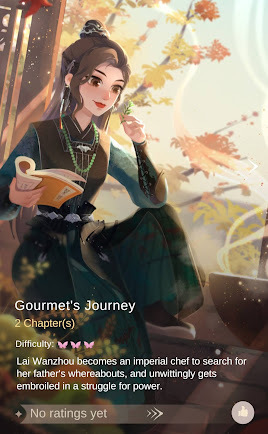
Players enter this book as Lai Wanzhou, a young chef who studied food preparation, cooking, and presentation under her father. One day, her father went to work at the palace and never returned home. Lai decides to enter a cooking competition that grants its winner an opportunity to work at the palace so she can look for him. After that, the plot twists and turns in so many different directions that it made me dizzy. Almost everyone turns out not to be who they say they are. It's a good mystery for people who enjoyed Have You Seen Claudia? There was one part that really surprised me in which the main character almost assassinates someone, which is not very fitting for a princess story. There are a few other mature themes that the game warns you about at the beginning, such as alcohol consumption, but it never gets too dark for a Time Princess novel.

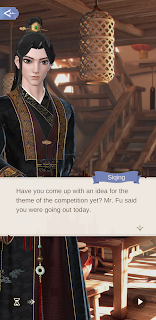
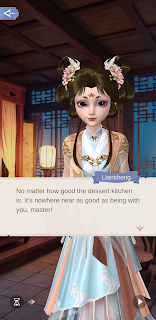
There are two companions in this story, but it isn't really a romance. Siqing is a mysterious nobleman who helps Lai win the cooking competition. She spends much of the story trying to discover his true identity and how it might relate to her father's whereabouts. Liansheng is a spirit of a koi fish that Lai can choose whether not to cook at the beginning of the story. She does not reveal her identity right away, but I thought it was pretty easy to figure out since this game has released so many similar visual novels. Liansheng is a loyal and adorable friend to Lai, but she also has some secrets of her own that are not revealed until much later. It was difficult to feel attached to either of these companions because both were keeping the protagonist the dark about a number of things throughout the story.
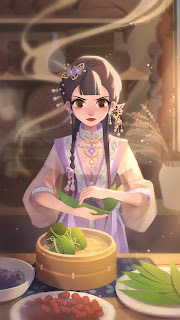
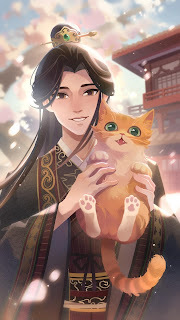

The dresses in this visual novel were beautiful, although they were pretty similar to outfits from the other Chinese stories that Time Princess has released in the past. I did like many of the two-piece skirt and top combos, which were a refreshing change from the traditional robes. My favorite was a lavender and sky blue ensemble decorated with flowers and bunny rabbits that reminded me of a clear spring day. There was also a formal baby blue robe with flowing golden accents and an elaborate hairstyle to match. I think I prefer Liansheng's outfit over the ones the protagonist could wear because the layers of pink and blue pair so pretty with the pearl accents and flowers in her hair. It's a shame I couldn't craft a version of that dress.
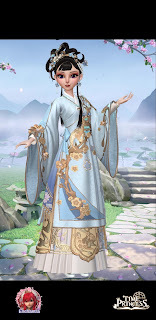
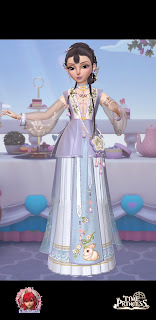

Overall, Gourmet's journey is nicely done but not what I was hoping for from the next visual novel in Time Princess. There is a lot of information about food and ingredients for people who are passionate about cooking and a compelling mystery to solve. The clothes are pretty but nothing new, and the companions are intriguing. I would recommend this story to anyone who enjoyed Tang Dynasty Hunter, White Snake, or Ancient Dreams. Meanwhile I'm still waiting for them to finally release Catherine the Great!

May 29, 2022
Review: Ever Cursed
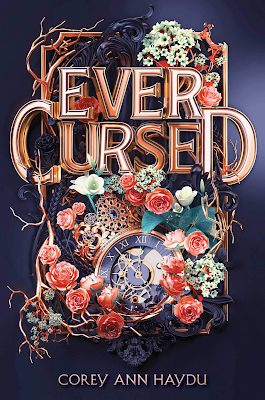
One of the most common criticisms of classic fairy tale princess stories is that they are misogynist. Princesses are always targets, witches and queens are always evil, and brave heroes always save the day. Over time, these stereotypes have been overturned with princesses who fight to defend their kingdoms, villains who are just misunderstood, and love interests who are evil or absent entirely. Writing a book that criticizes the old stereotypes to such a hyperbolic level is neither original nor eye-opening, but instead, misandric, a term that is rarely used because many feminists believe that there is nothing wrong with hating men. Yet, Ever Cursed is one of the most woke, pessimistic, and misandric books I have ever read, and it does all of this under the guise of classic fairy tale elements.
Ever Cursed alternates between the perspectives of Jane, a princess who is cursed to never eat, and Reagan, the witch who cursed her. If this book had been written twenty years ago, Regan would have been the villain. In the modern era of princesses forgiving those who have wronged them, she is a misunderstood hero because the king's actions are interpreted to be far worse than any curse. There are other princesses who were cursed by Reagan as well, but the book hardly focuses on any of them. Jane and her sisters are known throughout the kingdom as the Princesses of Without. One of her sisters is cursed to forget everything, another not to love, another not to sleep, and another still not to hope. That last one is particularly important because hope is something that this book severely lacks, which makes it feel empty as a princess story. Reagan tasks the princesses to find four objects that can be enchanted to break their curse, similar to Into the Woods .
This book is essentially a retelling of Disney's 2014 Maleficent film, but it does so in a more spiteful and pessimistic way. Maleficent made one mistake by cursing the daughter of the man who wronged her and comes to regret it shortly after getting to know Aurora. Reagan's mother was wronged by the king, so Reagan traps his wife in a box and curses all five of his daughters. Yet, she is the one we are supposed to root for because the king does not suffer when he sees his daughters suffering. Reagan's love interest, Abbot, is the only decent male character in the book, but even he does little to stop Reagan's tyranny other than scolding her for cursing the princesses. All of the other men in this world are portrayed as soulless uncaring creatures who find it charming that Princess Jane is slowly starving to death. This book suffers because it is impossible to tell a princess story through hate when the one thing princesses have in common is the strength of their love.
I can appreciate that the author of this book tried to do something different. In fact, the concept of witches growing permanent skirts around their bodies in different fabrics and colors for every spell cast was very creative. However, the book's message felt like an obligatory political statement that all modern mainstream media must follow. None of the characters were particularly interesting, and the villain bore too much resemblance to a certain recent politician to even be taken seriously. I would not recommend this book to anyone under the age of 18 due to its coarse language and references to sexual assault and eating disorders. Yet, its simplistic narrative structure and plot wouldn't hold the interest of many readers over the age of 18, so I suppose I wouldn't recommend it to anyone except as an educational study to see how far woke culture has gone.
May 23, 2022
Is This Snow White's New Look?
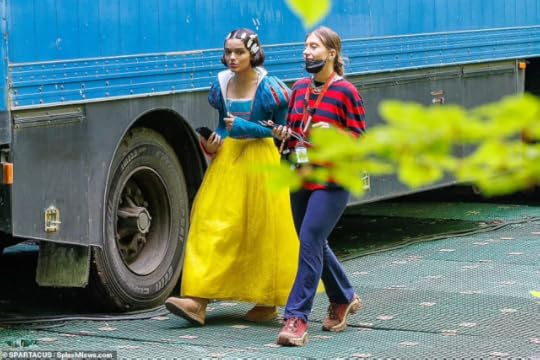
Rachel Zegler sports a surprisingly screen accurate rendition of Snow White's iconic dress with a blue bodice, white collar, yellow skirt, and red teardrop-shaped accepts on the puffed sleeves. And yet, it looks wrong. Could it be too accurate to the cartoon? In Disney's 2017 remake of Beauty and the Beast, Belle's dress lacked many of the intricate gold details that were painstakingly penciled into the animation. Here, Rachel dons every detail of Snow White's animated dress and then some with brocaded fabric, lace, and corset tie details added to the bodice. However, the bright canary yellow tulle detailing on the skirt is more reminiscent of an over-the-top Bibbidi Bobbidi Boutique costume for little girls than something an authentic princess may have worn in medieval times. Once Upon a Time did a much better job of portraying costumes that Snow White could have worn if she were a real person.

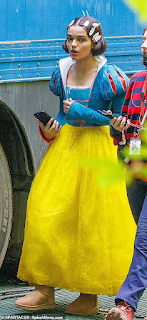
Keep in mind that these pictures were leaked by an anonymous source and not released officially by Disney, so they may not be congruent with her final look. Still, it's unfortunate that this is the first incarnation that we have of Rachel as Snow White, especially this early in the process. I was surprised to see any images this soon, especially when The Little Mermaid with is coming out sooner, and the only images we've seen of her in are in the coarse sailboat fabric she wrapped around herself when she washed up along the shore. Halle also released a photo of herself in a tail after production wrapped that caused a lot of confusion on whether or not it was her official look from. Due to the lighting with the sun setting behind her, it is difficult to make out what she is wearing regardless. The confusion behind these photos is reminiscent of that one. Are fans being tricked into thinking this will be Snow White's main look when it is actually a test costume or something she only wears in one scene?

Maybe the confusion behind these leaks are a sign that Disney should be more forthcoming with their official first looks for anticipated titles. In the age of social media, it's impossible to control everything that gets out to the public, so it would be better for them to release promo images within their control than to get bad press from poor quality photos that were not meant to be seen by the public. Disney released several promo photos of Princess Jasmine's costumes in Aladdin six months before the movie came out. Sure, Snow White and The Little Mermaid still have some more time left, but most fans are not willing to wait that long. They will grab at whatever they can get their hands on now, and those images look pretty sad in comparison to the costumes that these characters wear in the theme parks. Considering that this a modern retelling, I'm a little surprised they went with a classic dress for Snow White at all instead of donning her in warrior princess outfits from the get go.
Our first unofficial look at Disney's live-action Snow White came as quite the shock with eye-piercingly bright cartoonish colors. While this does not look very promising right now, keep in mind that it is not our first official look at the character. Hopefully, this costume is only used as a brief tribute to the animated film while the rest of the movie will contain more Once Upon a Time-inspired looks. Are you a fan of this Snow White costume, or do you think Disney could do better? Let me know in the comments!
May 22, 2022
Review: A Song of Sea and Shore
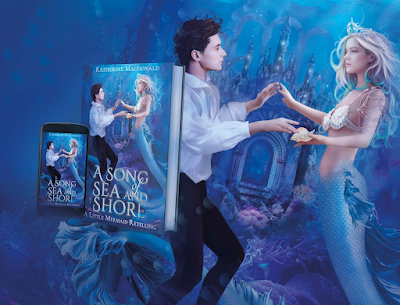
Like most incarnations of "The Little Mermaid," Neri is a headstrong and optimistic young mermaid who desires with all her heart to protect the humans, especially the prince she has loved since childhood. Unfortunately, her mother, Queen Maris, is more cynical about the ways of the world, especially after having lost a daughter. When the humans seem to have broken a treaty they made with the merfolk years earlier, Maris decides to summon a storm that will destroy the entire human kingdom. It's up to Neri to find a way to walk on land so she can warn them before it's too late. This aspect of the story reminds me of a Sofia the First special called The Floating Palace in which Sofia had to stop Queen Emmaline from creating a storm that would sink her family's ship because she didn't trust the humans. The special featured Ariel from Disney's The Little Mermaid , and it was interesting to see the same storyline incorporated into an alternate version of the fairy tale.
Though this is clearly a "Little Mermaid" retelling, I noticed several references to "The Snow Queen," another popular Hans Christian Andersen story, sprinkled throughout the book. Even the prince's name, Kai, matched the name of the boy that the protagonist in "The Snow Queen" had to rescue through her love and memories toward him. There were other Nordic names as well, many of which were used in Disney's Frozen adaptation, such as Anna, Sven, and Hans. The "frozen heart" angle was interesting. Although Kai still has his emotions intact, after becoming human, Neri realizes that he and the rest of his kingdom seem to have lost all their memories of mermaids. As a result, Kai has forgotten why Neri is so important to him. She must find ways to communicate who she is without her voice, many of which have been used in other versions of this story, such as sign language and writing, though Neri is disappointed to discover that humans have a different written language than the merfolk.
While many of the changes the author made to the fairy tale work in this book's favor, many of them take away from the heartrending aspects of the original. For instance, Neri no longer has to worry about dying if Kai doesn't remember her, though he will lose his entire kingdom if she is unable to communicate the danger that her mother poses. I also thought the prince's fiancée, Princess Sophia, was not believable at all as a character. The author doesn't like stories about women becoming rivals over men, so she made Sophia way too good to be true. Sophia immediately realizes that Kai and Neri are in love and does everything in her power so they can be together. While this character was not exactly evil in the original story, there was still some tension based around a misunderstanding that she was the one who rescued the prince from drowning which I felt was missing here. I think it would have been more interesting if Neri had to build a friendship with Sophia to help her realize the misunderstanding.
All in all, A Song of Sea and Shore is a perfectly fine retelling of "The Little Mermaid." It develops a unique kingdom and culture around merfolk and gives the protagonist more motivation to trade her voice for legs. However, there were some changes to the story that made it less appealing to me, such as the sexualized version of mermaids, which is fairly common in mythology, and the lack of stakes for Neri because the danger is transposed to the human characters. There were a few surprises involving Neri's sisters that I really enjoyed. If you are a fan of "The Little Mermaid" and are looking for something new to read, this is a good one to check out.



